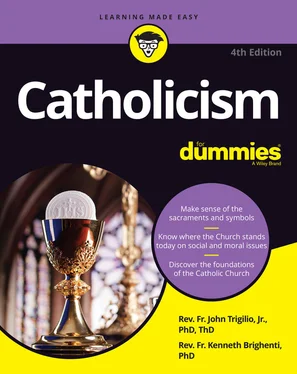Bishops celebrate most Masses at the cathedral church. In addition, it’s often the place where the Chrism Mass (also known as the Mass of the Oils ) takes place — unless the bishop decides to have it elsewhere in the diocese. (Curious? See the sidebar “Nope, the Mass of the Oils has nothing to do with your car’s engine” for details about this special Mass.)
Cathedrals also have daily and weekly Mass like other parishes, as well as weddings, funerals, baptisms, and such. But the pride of the cathedral is in the ordinations to the episcopacy, priesthood, or diaconate, as well as the Chrism Mass. (For more on ordination and Holy Orders, see Chapter 9.)
Note: Only the bishop may sit in his cathedra, so any other priest celebrating Mass must use another chair.
NOPE, THE MASS OF THE OILS HAS NOTHING TO DO WITH YOUR CAR’S ENGINE
The Chrism Mass takes place on Holy Thursday or some other day of Holy Week (the week before Easter), and all the priests of the diocese are asked to be present if possible. At this Mass, the bishop formally blesses olive oil in enormous multi-gallon containers to be distributed to all the parishes and priests throughout the diocese. Three oils are blessed at this annual Mass:
The Oil of Catechumens (Oleum Catechumenorum) is used to bless people prior to their Baptism and during enrollment as catechumen, students of the faith preparing for Baptism.
The Oil of the Sick (Oleum Infirmorum) is appropriate when administering the Sacrament of the Anointing of the Sick, formerly known as Extreme Unction.
Chrism Oil (Sacrum Chrisma), also called Sacred Chrism, is for newly baptized persons, and the bishop also uses Chrism Oil when administering the Sacraments of Confirmation or Holy Orders and to consecrate altars, churches, chalices, and so on. Balsam is added to olive oil to make it more fragrant.
Vicars general aren’t military leaders like Generals Montgomery, De Gaulle, and MacArthur. They’re priests who are second in command in the diocese and appointed by the bishop to help him govern the local Church. Sometimes, episcopal vicars are also appointed to assist the bishop in certain areas, such as vocations, the marriage tribunal, clergy personnel, Hispanic or minority ministries, and so on. In large dioceses, such as New York or London, vicars general are often auxiliary bishops, ordained bishops who assist the bishop of the diocese in the same way any other vicar general does, except that they can help the bishop ordain deacons and priests and celebrate the Sacrament of Confirmation.
Often, these priests are given the honorary title of monsignor at the request of the local bishop . This title has no extra authority, dignity, or salary. You can recognize a monsignor by the color of his cassock — a long, close-fitting garment worn by clerics. This honorary title may be bestowed in three different forms:
Papal Chamberlain: Also known as Chaplain of His Holiness, this is the lowest ranking of the title of monsignor. These monsignors wear black cassocks with purple buttons and trim.
Domestic Prelate: These monsignors are also known as Prelates of Honor, and they wear purple or black cassocks with red buttons and trim.
Protonotary Apostolic: This is the highest ranking of the title. It’s designated by a purple ferraiolone, a silk cape worn over the cassock.
The parish priest (also known as a pastor ) is the next clergy in the hierarchy after the vicar general. Pastors are appointed by the bishop and represent the bishop to the local parish, which is a collection of neighborhoods in one small region of the county within a given state.
Some pastors are helped by a priest called a parochial vicar (formerly known as a curate or an assistant pastor ) and/or sometimes by a permanent deacon, religious sister, or lay parishioner as a pastoral associate. The parish council and finance committees, which are made up of lay parishioners for the most part, advise and counsel the pastor but don’t have administrative or executive authority.
The typical Catholic priest isn’t what you see in movies or on TV. Priests are expected to obtain a graduate, post-graduate, or doctoral degree, and they often spend anywhere from 4 to 12 years in the seminary, which is the equivalent of Protestant divinity school. Most have at least a master’s degree in divinity or theology, if not a higher academic degree on par with medical doctors and attorneys.
Besides scholastic training, seminarians also receive practical experience from apostolates, which are weekly or summertime assignments in parishes, hospitals, nursing homes, prisons, classrooms, and such, to unite pastoral education with theological and philosophical education.
A parish priest celebrates daily Mass, hears confessions every week, gives marriage counseling, provides prenuptial counseling, gives spiritual direction, anoints and visits shut-ins and the sick in hospitals and nursing homes, teaches Catechism (a book that contains the doctrines of Catholicism) to children and adults, baptizes, witnesses marriages, performs funerals and burials, attends numerous parish and diocesan meetings, prays privately every day, does spiritual and theological reading, and finds time to relax now and then with family and friends. And once a year, he’s expected to make a five-day retreat in addition to doing his regular spiritual direction and daily prayer. Yeah, it’s a busy job.
With 1.34 billion Catholics worldwide (17.7 percent of the world population) and only about 414,336 priests to minister to their spiritual needs, that leaves an average of about one priest per 3,234 Catholics. Some areas have as many as 6,000 or more people per priest.
The hub in the wheel: The parish church
The parish church is where the priest does his job and where most Catholics hang out on Saturday evening or Sunday morning to attend Mass.
The local Catholic parish is often named after a title of the Lord Jesus Christ, such as Blessed Sacrament or Sacred Heart; after a title of the Blessed Virgin Mary, such as Our Lady of Good Counsel or Our Lady of Seven Sorrows; or after one of the saints, such as St. Ann, St. Bernadette, or St. Joseph. The parish is the heart of the diocese because it’s where most Catholics get baptized, go to confession, attend Mass, receive Holy Communion, are confirmed, get married, and are buried from.
Some American parishes have a parochial school connected to them, but few of them have a convent of nuns who staff the school, although you can still find them here and there. Catholic grade schools were once the bread and butter of vocations and often fed into Catholic high schools and colleges. In other words, these parish schools encouraged boys and girls to consider becoming priests and nuns, and most students continued their Catholic education all the way through college even if they didn’t have a religious vocation. But economics, demographics, and declining numbers of religious sisters and brothers have resulted in the consolidation and closing of many parish schools. Public schools in many places are well staffed, well funded, and more accessible.
An even rarer occurrence is the parish cemetery. Nowadays, the diocese has centralized schools and cemeteries, but a few old country parishes still have a graveyard in the back of the property.
Father, are you a diocesan or religious priest?
Читать дальше












